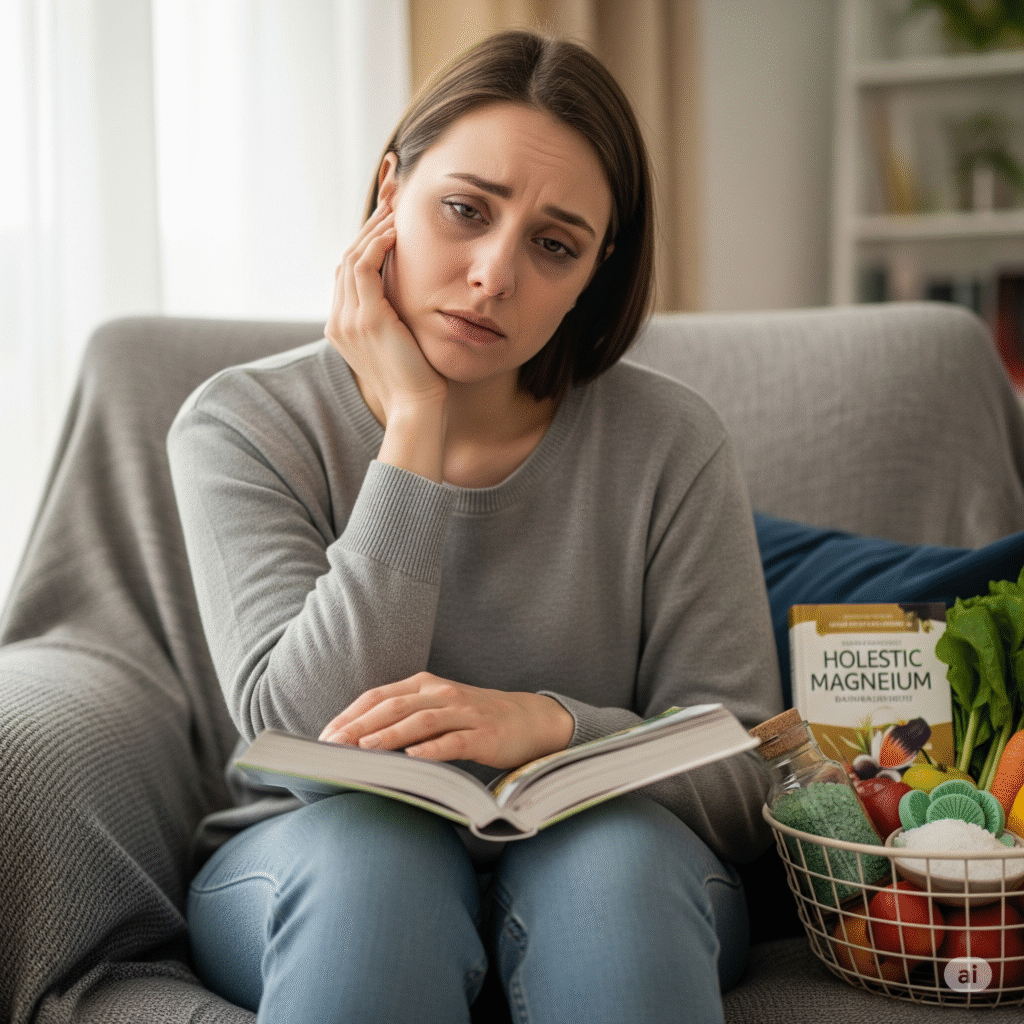
⚠️ Affiliate Disclaimer: This post may contain affiliate links, which means I may earn a small commission — at no extra cost to you — if you make a purchase through one of these links. I only recommend products or services I genuinely trust and believe can provide value. Thank you for supporting My Medical Muse!
Why Your Period Blood turns Brown at the End 7 Fascinating Reasons and When to Worry
When Your Period Blood Changes Color
You reach the tail end of your period, the cramps are fading, the flow is lighter, but suddenly, the blood looks brown instead of red. It’s easy to panic or wonder if something’s wrong, but here’s the truth, brown period blood at the end of your cycle is usually completely normal.
Menstrual blood changes color as it ages. What starts out bright red can turn dark red, rusty, or brown by the time it leaves your body. However, understanding why this happens and when it could signal an imbalance helps you feel more confident about your menstrual health.
Let’s break it down step by step from the science of color changes to when brown blood might need attention.
1. Old Blood Leaving the Uterus
The most common and most harmless reason your period blood turns brown at the end is simply because it’s old blood. When your menstrual cycle begins, the blood leaving your uterus is fresh and oxygen-rich, so it looks bright red or crimson. This blood flows quickly, especially during the first two days when uterine contractions are strongest and the lining sheds most actively.
However, as your period winds down, your uterine lining has already been mostly shed. What remains are small traces of tissue and blood that take longer to leave the uterus, because this slower-moving blood is exposed to air for a longer time, the iron in the hemoglobin begins to oxidize, turning the blood a darker hue.
Think of it this way, just like a sliced apple turns brown after sitting out, menstrual blood darkens when it lingers before being expelled.
In short:
- Bright red equals freshly oxygenated blood leaving the body quickly
- Dark red to brown equals older, oxidized blood that’s been in the uterus or vagina longer
So if your period ends with brown discharge, that’s simply your body wrapping up its natural cleanup phase, not a sign of trouble.
In fact, it’s quite a positive indicator that your uterus is clearing out the last remnants of the endometrial lining efficiently before your next cycle begins.
2. Slower Flow and Hormonal Changes
Your menstrual flow is governed by a delicate interplay of hormones, primarily estrogen and progesterone. These two hormones determine how thick your uterine lining becomes and how strongly it sheds each month. During the early days of your period, estrogen levels are higher, promoting a robust flow. As your period progresses, progesterone gradually rises, signaling your body to start preparing for the next phase of the menstrual cycle, ovulation.
This hormonal shift causes your uterine muscles to contract less intensely, which naturally slows down blood flow. The slower your flow, the longer the blood remains inside your reproductive tract before leaving, which again allows more oxidation to occur.
That’s why brown or dark rust-colored discharge is especially noticeable in the last couple of days of your period or even a day afterward.
You might observe brown spotting:
- A day or two before your period completely stops
- When you wipe after using the bathroom
- On lighter days when the discharge is minimal or mixed with cervical mucus
This transition is completely normal. It’s simply your body recalibrating as hormone levels stabilize and your uterus completes its shedding. If you track your cycles, you’ll often notice this brown phase coincides with the hormonal “reset” that happens right before your next follicular phase begins. It’s not a problem, it’s part of your body’s rhythm.
3. Light “End-of-Period” Spotting
Even after your main flow stops, your uterus may not be entirely done yet. Sometimes, a small amount of leftover blood lingers in the uterine cavity or upper vaginal canal. This blood doesn’t come out in a steady flow, it exits slowly, mixing with cervical mucus and oxygen along the way, resulting in brown spotting or light brown discharge.
This phenomenon is commonly called end-of-period spotting, and it’s your uterus’ way of finishing the final phase of menstruation, because the volume of blood is so small, it may not appear on a pad or cup but might show up when you wipe, or you might notice light stains on underwear for a day or two after you think your period is over.
Here’s what typical end-of-period spotting looks like:
- Color: Brown, dark rust, or occasionally tan
- Texture: Light, sticky, or slightly creamy due to cervical mucus
- Duration: 1-3 days after your period appears to have ended
- Symptoms: Mild cramps (if any) or no discomfort at all
In essence, this is your body’s natural post-period “housekeeping.” It’s flushing out every last trace of the endometrial tissue to ensure your uterus is fresh and ready for a new cycle.
Some women experience this phase more noticeably than others, it can depend on factors like:
- Hydration levels (thicker blood moves more slowly)
- Hormonal balance (estrogen helps maintain a steadier flow)
- Physical activity (gentle movement can help the uterus contract efficiently)
As long as this spotting doesn’t have a foul odor, persist for more than a few days or come with pain or pelvic pressure, it’s nothing to worry about. It’s just your body doing what it does best, completing the cycle, literally and biologically.
4. Iron Levels and Blood Oxidation
The iron content in your blood can subtly influence how your menstrual flow looks, especially toward the end of your period.
Menstrual blood is rich in hemoglobin, a protein inside red blood cells that binds to oxygen and gives blood its red color. Hemoglobin contains iron and when that iron interacts with oxygen, oxidation occurs, darkening the blood to a brown or rusty hue.
So, if your flow is lighter and slower, the blood stays in the uterus or vagina longer, gets more oxygen exposure, and turns brown before it exits.
In contrast, during heavier flow days, blood exits the body rapidly, giving it less time to oxidize, that’s why early-period blood appears bright red or scarlet.
A rusty-brown tone doesn’t necessarily mean anything is wrong, but it can sometimes hint at lower iron levels, especially if you also feel tired, dizzy, or weak after your period. It’s common to lose some iron during menstruation, particularly if your flow lasts longer than five days or tends to be heavy.
Supporting your body’s iron stores can make a big difference in how you feel post-period. Try incorporating:
- Iron-rich foods: spinach, lentils, red meat, organ meats, beans, pumpkin seeds, and tofu.
- Vitamin C-rich foods: oranges, bell peppers, or strawberries to enhance iron absorption.
- Iron supplements: if prescribed by your doctor (especially if you have recurring fatigue or anemia).
Balanced iron levels not only improve energy but also support the oxygenation process that keeps your blood healthy and your cycles regular.
5. Birth Control or Hormonal Contraceptives
If you use hormonal birth control, pills, IUDs, patches, injections, or implants, you’ve probably noticed subtle changes in your period’s flow, timing, or color. That’s because birth control directly influences your estrogen and progesterone levels, which regulate how your uterine lining (endometrium) grows and sheds.
Hormonal contraceptives can:
- Thin the uterine lining, resulting in lighter or shorter periods
- Alter ovulation timing, sometimes skipping it entirely
- Change cycle patterns, creating mid-cycle spotting or longer gaps between periods
When your uterine lining becomes thinner, there’s less tissue to shed during menstruation. As a result, the small amount of blood released may take longer to leave the body, allowing oxidation to turn it brown or dark red.
Sometimes, users experience breakthrough bleeding, small amounts of spotting that occur between periods. This blood often looks brown or dark because it’s minimal and older by the time it exits, while this effect is usually harmless, it’s good to stay observant.
See your healthcare provider if:
- Spotting becomes heavy or constant
- You experience cramping between periods
- You notice brown discharge lasting several weeks
In most cases, a simple adjustment in your hormonal dosage or method (for example, switching pill types or trying a different IUD) resolves the issue.
Birth control affects everyone differently, so brown spotting isn’t a red flag, it’s often just a sign that your body is adapting to hormonal changes.
6. Post-Ovulation and Implantation-Like Bleeding
Brown discharge doesn’t always appear at the end of your period, sometimes it pops up in the middle of your cycle or about two weeks after ovulation. When that happens, it can be linked to post-ovulation spotting or, in some cases, implantation bleeding.
Post-Ovulation Spotting
During the second half of your cycle, after ovulation, your body produces more progesterone to support the uterine lining.
Occasionally, progesterone levels dip slightly before stabilizing again. This small hormonal fluctuation can trigger the release of a bit of old blood from the uterine wall because this blood is minimal and slow-moving, it appears brown, light red, or pinkish.
This is considered normal and often lasts less than 48 hours. It’s simply a hormonal “hiccup” that doesn’t require treatment.
Implantation Bleeding
If you’re sexually active and could be pregnant, brown or pink spotting around 6-12 days after ovulation could be an early sign of implantation.
When a fertilized egg attaches to the uterine lining, a tiny amount of blood is released. Since it’s such a small volume, it oxidizes quickly, giving it a brownish tint.
Other clues that may accompany implantation bleeding:
- Mild cramping (lighter than period pain)
- A small, one-time brown or pink stain
- Timing about a week before your expected period
If you’re unsure, the simplest step is to take a pregnancy test after a few days. If negative but spotting continues or feels unusual, talk to your doctor to rule out hormonal imbalance or other causes.
7. Cervical or Vaginal Health Factors
While brown period blood is most often normal, there are cases where it might signal a cervical or vaginal issue, particularly when it occurs outside your usual menstrual window or comes with other symptoms.
The cervix and vaginal walls are delicate, and even minor disruptions can cause light bleeding that later oxidizes to brown. Some benign (non-serious) reasons include:
- Cervical irritation after sexual activity, especially if the cervix was touched or inflamed
- Post-Pap smear spotting, due to gentle scraping during screening
- Cervical or endometrial polyps, which are small, soft growths that may bleed slightly
- Vaginal infections, such as bacterial vaginosis or yeast infections, that alter discharge texture and color
In all these cases, the small amount of blood released travels slowly, turning brown before it leaves the body.
However, it’s important to pay attention to context and accompanying symptoms.
You should consider booking a check-up if:
- There’s a strong or fishy odor
- The discharge has a chunky or unusual texture
- You feel pelvic pain, itching, or burning
- Brown discharge occurs throughout your cycle, not just at the end
These signs could suggest an underlying infection, inflammation, or (rarely) precancerous cervical changes, all of which are treatable once identified.
In contrast, if you only notice brown discharge at the end of your period, after sex once in a while, or after physical exertion, it’s likely nothing more than mild irritation or leftover old blood.
In short, brown blood can sometimes come from your cervix, not your uterus and knowing the difference helps you respond wisely rather than worry unnecessarily.
The Science Behind Menstrual Blood Color Changes
Let’s dig a little deeper into what’s happening on a biological level.
Hemoglobin Breakdown
Red blood cells contain hemoglobin, which gives blood its red color. When exposed to air, hemoglobin breaks down into methemoglobin and hemosiderin, both of which are darker compounds, turning the blood brown or blackish.
This process is called oxidation and is completely natural once the blood leaves the uterus.
pH and Vaginal Flora
The vagina maintains a slightly acidic environment (pH 3.8-4.5) due to beneficial bacteria like Lactobacillus.
This environment not only protects against infections but also influences how blood interacts with oxygen and vaginal fluids.Old blood can mix with cervical mucus and appear darker or even slightly sticky as a result.
When Brown Period Blood Is Totally Normal
Brown blood at the end of your period is normal if:
- It occurs only during the last 1-2 days
- There’s no foul smell or discomfort
- Your cycle is otherwise regular
You might also notice:
- Brown discharge at the beginning of your period (as your body “warms up” to the flow)
- A few brown spots after your period (the uterus completing its shedding)
In both cases, it’s simply older blood making its way out.
When Brown Blood Might Need Medical Attention
Sometimes, the change in color or timing hints at an underlying issue.
Here’s when you should check in with your doctor:
- Brown discharge lasts longer than 7-10 days
- There’s a foul or fishy odor
- You feel pelvic pain or pressure
- The discharge happens mid-cycle or after sex
- Your cycles have suddenly become irregular or extremely light/heavy
Possible causes include:
- Hormonal imbalance (thyroid issues, PCOS, or stress)
- Endometriosis or adenomyosis
- Fibroids or uterine polyps
- Infections (bacterial vaginosis, yeast, or STIs)
While these conditions are treatable, they often benefit from early detection, so don’t ignore persistent changes.
How to Support a Healthy Menstrual Cycle
You can’t stop old blood from turning brown but you can support your body’s natural rhythm with healthy habits.
1. Nourish Your Iron Levels
Replenish the iron lost during menstruation with foods like:
- Spinach, kale, and beets
- Red meat or liver
- Lentils, tofu, and pumpkin seeds
Pair iron-rich foods with vitamin C (like oranges or bell peppers) to boost absorption.
2. Stay Hydrated
Dehydration thickens your blood, making it harder to flow freely, which can cause more brown spotting.
Aim for at least 2 liters of water per day during your cycle.
3. Support Hormonal Balance
- Get enough sleep (7-9 hours)
- Manage stress (yoga, meditation, or journaling)
- Include healthy fats (avocado, olive oil, flaxseeds) for hormone production
4. Track Your Cycle
Using a period tracker app helps you spot changes in color, flow, or timing.
Patterns reveal a lot about your hormone health and can guide you to seek help if needed.
5. Avoid Excessive Douching or Harsh Products
These can disrupt your vaginal pH and natural flora, leading to odor or abnormal discharge.
Stick to mild, unscented cleansers for the vulva (never inside the vagina).
Common Myths About Brown Period Blood
Let’s bust a few popular misconceptions:
Myth | Truth |
Brown blood means an infection | Not necessarily, most often it’s old blood |
You’re not fertile if your period ends brown | False, color doesn’t indicate fertility |
It means you’re pregnant | Only if it occurs outside your period and coincides with implantation |
It’s a sign of “dirty blood” | Completely false, it’s just oxidized hemoglobin |
Brown blood is your body’s natural way of finishing your menstrual process, not a sign of impurity.
The Takeaway
Brown period blood at the end of your cycle is your body saying:
“I’m done for this month, just clearing out the last bit.”
It’s old, oxidized blood that’s been sitting in the uterus or vagina for a little while before exiting.
In most cases, it’s harmless and even a sign of a normal, efficient menstrual process but if the color change is persistent, accompanied by odor, pain, or irregular cycles, don’t ignore it, your body might be signaling something deeper.
Your period isn’t just a monthly inconvenience, it’s a vital sign of reproductive and hormonal health.
Listening to it can help you catch imbalances early and stay in tune with your body’s rhythm.
Quick Summary
Cause | Typical Appearance | Is It Normal? |
Old blood | Dark brown | Normal |
Slow flow | Brown, thick | Normal |
Hormonal change | Light brown | Normal |
Birth control | Brown spotting | Monitor |
Infection or polyps | Brown + odor/pain | See doctor |
Implantation | Pinkish brown | If sexually active |
Final Thought
Your body communicates constantly and your menstrual blood color is one of its languages. Brown period blood at the end is simply your body’s natural cleanup phase, wrapping up the menstrual cycle in preparation for the next.
Stay observant, nourish your body, and remember:
Healthy cycles come in many shades of red and brown is often just part of the spectrum.
👩⚕️ Need Personalized Health Advice?
Get expert guidance tailored to your unique health concerns through MuseCare Consult. Our licensed doctors are here to help you understand your symptoms, medications, and lab results—confidentially and affordably.
👉 Book a MuseCare Consult NowRelated Blog Post You Might Like:
- 7 Surprising Reasons Why You Have Mucus in Period Blood and Why It’s Usually a Good Sign
- 7 Surprising Reasons Why Your Discharge Increased Suddenly Mid-Cycle And Why It’s Usually a Good Sign
- 8 Surprising Reasons Why Your Period Blood Looks Watery and Why It’s Usually Nothing to Worry About
- 7 Interesting Reasons Why Your Body Feels Heavy Before Your Period and Why It’s Totally Normal
- 10 Surprising Reasons Why Your Period Suddenly Became Shorter This Month and Why It’s Not Always Bad


